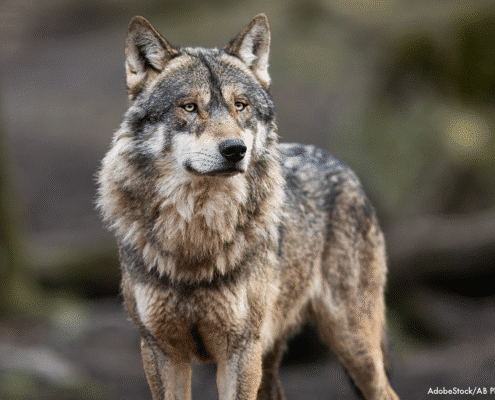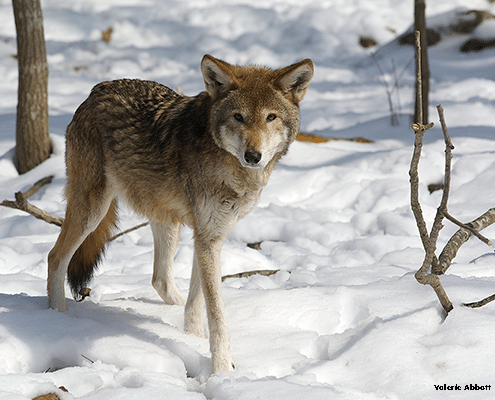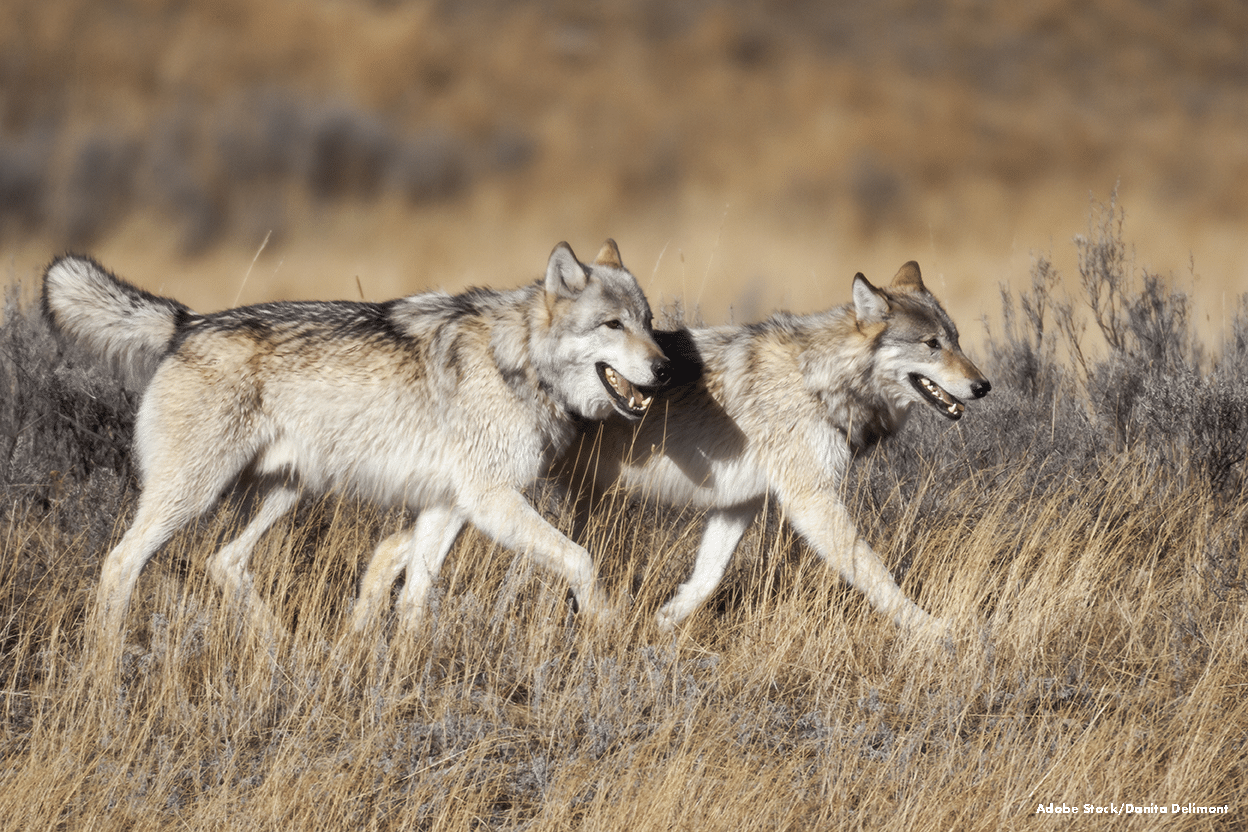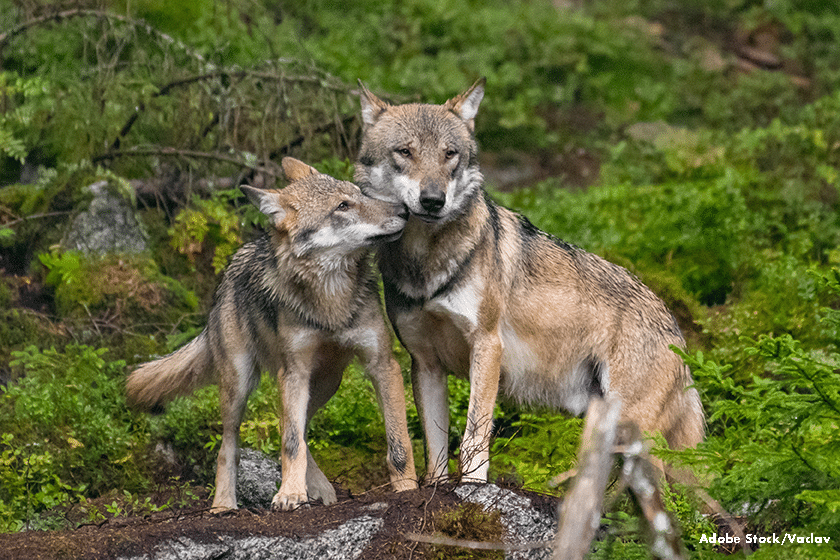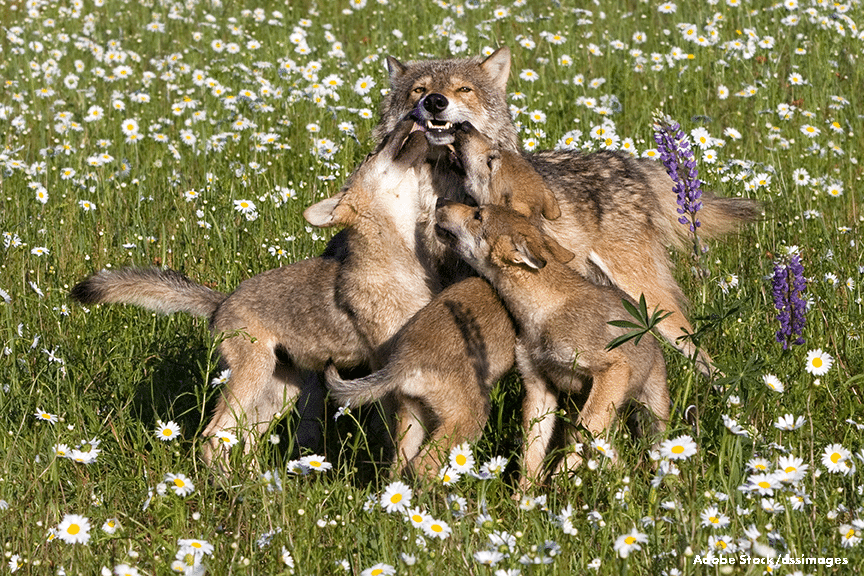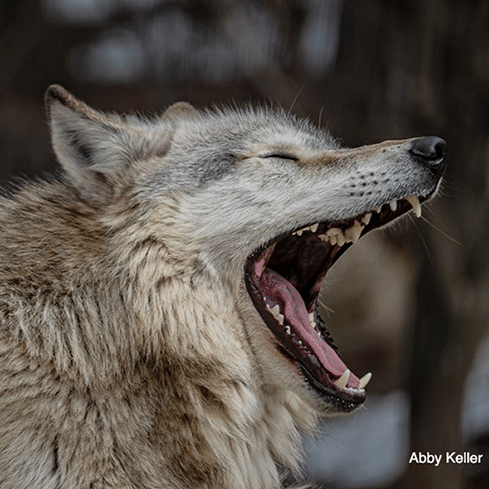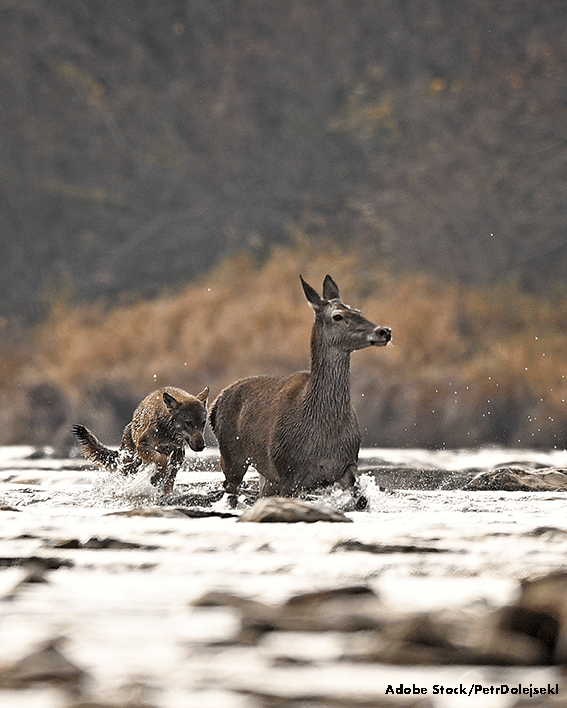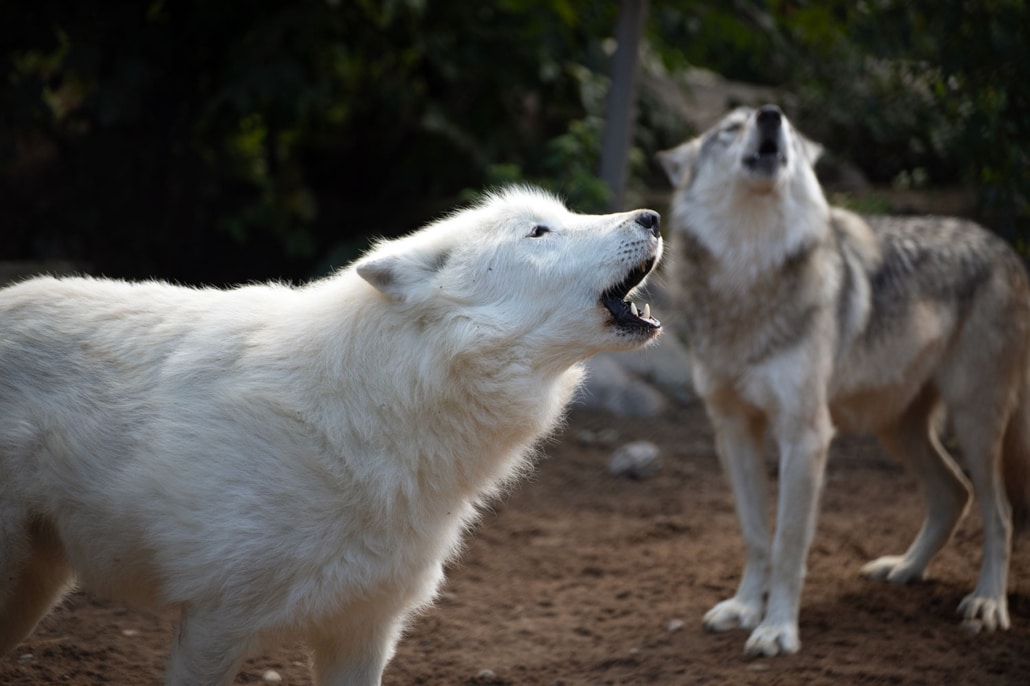Researchers are discovering more about wolves every year. Direct observation of these complex and intelligent animals in places like the high Arctic and Yellowstone, advances in genetics, and sophisticated tracking devices have unlocked many secrets. However, much about the wolf remains a mystery, and the adage “Never say ‘Never,’ and never say’ Always ‘” when the subject is wolves is still true.
Check out the Wolf FAQs below for the answers to the most commonly asked questions about wolves. To dive deeper into a topic, you can read full articles and scientific papers about the following questions. We recommend you explore this website’s Wolf Info section for more comprehensive information, including the “Books and Videos About Wolves” section under Basic Wolf Information.
How many species of wolves are there in the world?
There are two universally recognized species of wolves in the world: the gray wolf (Canis lupus) and the red wolf (Canis rufus). Two other members of the canine family are considered wolves by some researchers, while others classify them as distinct species. The use of molecular genetic research on wolves suggests that there may be two additional species of wolf in the world. Some scientists question whether the Ethiopian or Abyssinian wolf (Canis simensis) is actually a wolf or a jackal. Other researchers have presented strong evidence that the eastern timber wolf (Canis lupus lycaon), may be a distinct species, the eastern wolf (Canis lycaon). Due to the complex nature of studying wolves using molecular genetics to distinguish species, the process takes a significant amount of time to reach solid conclusions.
What are the subspecies (races) of the gray wolf?
There is no scientific consensus about the gray wolf (Canis lupus) subspecies. Recent studies on the morphology and genetic identification of wolf populations have highlighted issues with subjectivity and scientific differences regarding wolf subspecific designations. Due to these recent findings, the International Wolf Center now refrains from designating our ambassadors by subspecies or using wolf subspecific designations in its literature, except possibly to discuss questions related to the subject itself.
Subspecies are often difficult to distinguish from one another. This is because wolves are so mobile and travel such great distances. They interbreed where their ranges overlap so that their populations tend to blend together rather than form distinctive boundaries. The different traits we see are likely the result of geographic range, available habitat, and prey base. But one wolf is, in reality, like any other wolf in terms of natural history and behavior. There are far more commonalities among wolves than differences. All wolves are social animals that live and hunt in families, known as packs, although adult wolves can and do survive alone. Most wolves hold territories, and all communicate through body language, vocalization and scent marking.
You can read more about recent research here.
Is the red wolf an actual wolf or a wolf/coyote hybrid?
No single hypothesis for the origin of the red wolf is universally accepted by scientists. DNA analysis and morphological evidence support recognition of the red wolf as a distinct species. (See Wolves: Behavior, Ecology, and Conservation – Chapter 9).
What are the main differences between red wolves and gray wolves?
Red wolves are larger than coyotes and smaller than gray wolves. They are buff-colored or brown with some black along their backs. The backs of their ears, head and legs are often tinged with a reddish color. Their legs are long, and they have tall, offset ears. The red wolf diet consists mainly of white-tailed deer and small mammals such as marsh rabbits, raccoons and nutria.
What is the legal status of the red wolf?
The red wolf has a federally endangered status throughout its 29-state historic range. Non-essential experimental status (see Glossary) applies only to the 5-county red wolf recovery area comprising the Albemarle Peninsula in northeastern North Carolina.
What is a wolf pack?
A wolf pack is a cohesive family unit consisting of the adult parents and their offspring of the current year, and perhaps the previous year, and sometimes two years or more. Wolf parents were once referred to as the alpha male and alpha female, or the alpha pair. These terms have been replaced by “breeding male,” “breeding female,” and “breeding pair,” or simply “parents.” Adult parents are usually unrelated, and other unrelated wolves may occasionally join the pack.
How many wolves are in a pack?
Pack size is highly variable and fluid because of the birth of pups, dispersal, and mortality. Prey availability and size are also factors. Where prey animals are smaller, packs tend to be small. Where prey is large, the packs may be larger. For example, in Alaska and northwestern Canada, some packs reportedly have over 20 members. One pack (Druid Peak pack) in Yellowstone National Park once swelled to over 30 members, but this is highly unusual and not necessarily an advantage. More pack members mean more food must be obtained. Wolf packs are generally largest in late autumn when the nearly grown pups are strong enough to hunt with the adults. During the winter months, some wolves may disperse to find mates and establish their own territories. Others die, and by spring, before the arrival of a new crop of pups, the pack size has often diminished.
Red wolf packs are generally smaller than gray wolf packs, typically consisting of 2 to 8 members, although a pack of 12 has been observed in the wild.
What is the size of a wolf pack’s territory?
In most regions where wolves live, each wolf pack has its own territory, an area in which it lives, hunts and raises its offspring and which it actively defends against other canids (dog-like animals), including other wolves. Exceptions are nomadic wolves, whose prey is migratory, such as the tundra wolves that follow the caribou herds on their annual migrations over vast distances. Territory size is highly variable and depends on several factors, including prey abundance, the nature of the terrain, climate, and the presence of other predators, such as other wolf packs. Gray wolf territories in the lower 48 states may be less than 100 square miles, while territories in Alaska and Canada can range from about 300 to 1,000 square miles or more.
Red wolf territories in northeastern North Carolina vary in size, but most are estimated to range between 38 and 87 square miles.
When do wolves breed?
Wolves breed once a year, typically in late winter or early spring, depending on their geographical location. For example, gray wolves in the Western Great Lakes region breed from February to March, while those in the Arctic may breed a few weeks later, from March to April.
Red wolves usually breed in late January or early February.
What is the gestation (pregnancy) period of a wolf?
The gestation period (length of pregnancy) of gray and red wolves is usually around 63 days.
How many pups are born in a pack each year?
A mature female wolf comes into estrus once a year. Thus, a breeding pair produces one litter of pups each spring, but in areas of high prey abundance, more than one female in a pack may give birth. An average litter size for gray and red wolves is 4 to 6, but sometimes fewer pups are born and sometimes more. Several, or even all, may die if food is not readily available for the fast-growing youngsters. Additionally, other predators and diseases, such as distemper and canine parvovirus, may also kill young pups.
How much do wolf pups weigh?
Gray and red wolf pups weigh about a pound at birth. The newborns are blind and deaf, and they depend on their mother for warmth. In about two weeks, their eyes open, and in three weeks, they emerge from the den and begin to explore their world. Growth is rapid, and by the time the pups are 6 months old, they are almost as big as the adults.
How much do adult wolves weigh?
Wolves vary significantly in size depending on their habitat. The smallest wolves are found in the southern parts of the Middle East, where the Arabian wolf may weigh as little as 30 pounds. Adult female gray wolves in northern Minnesota weigh between 50 and 85 pounds, and adult males between 70 and 110 pounds. Gray wolves are larger in the northwestern United States, Canada, and Alaska, as well as in Russia, where adult males weigh 85 to 115 pounds and occasionally reach 130 pounds. Males generally weigh about 20 percent more than females. Wolves reach their adult height, length, and weight within the first one to two years. Most look like adults by late autumn of their first year.
Red wolves are intermediate in size and have an appearance that falls between that of gray wolves and coyotes. Adult female red wolves weigh 40 to 75 pounds, while males weigh from 50 to 85 pounds.
How long and tall are wolves?
As with weight, a wolf’s length and height are variable in different areas of the world. The figures that follow are commonly used to describe the larger subspecies of wolves in North America, Europe and central Asia. They are not accurate for several of the smaller subspecies in the southern latitudes of the Middle East, for example. The average length (tip of nose to tip of tail) of an adult female gray wolf is 4.5 to 6 feet; adult males average 5 to 6.5 feet. The average height (at the shoulder) of a gray wolf is 26 to 32 inches.
The average length (tip of nose to tip of tail) of an adult red wolf is 4.5 to 5.5 feet. The average height (at the shoulder) of an adult red wolf is about 26 inches.
How big is a wolf’s track?
The size of a wolf’s track is dependent on the age and size of the wolf, as well as the substrate in which the track was made. A good size estimate for a gray wolf’s track size is 4 1/2 inches long by 3 1/2 inches wide. In comparison, a coyote’s track will be closer to 2 1/2 inches long by 1 1/2 inches wide. Only a few breeds of dogs leave tracks longer than 4 inches (Great Danes, St. Bernards, and some bloodhounds). Red wolves have smaller feet than gray wolves.
All wolves have feet superbly adapted to long-distance travel over different types of terrain and through (and over!) snow. The wolf’s blocky feet and long, flexible toes conform to uneven terrain, thus allowing the animal to maintain speed when necessary as well as a tireless, ground-eating trot when traveling.
How many teeth does an adult wolf have?
Adult gray and red wolves have 42 highly specialized teeth, while adult humans have 32. The canine teeth, or fangs, can be 2 1/2 inches long and are used for puncturing and gripping. The incisors are for nipping small pieces of meat; the carnassial teeth are like scissors and knives. Wolves use them to shear flesh away from bones. Molars are for grinding and crushing.
How strong are wolves’ jaws?
The massive molars and powerful jaws of a wolf are used to crush the bones of its prey. The biting capacity of a wolf is 398 pounds of pressure per square inch. The strength of a wolf’s jaws makes it possible to bite through a moose femur to get to the bone marrow. In comparison, a domestic dog has a biting pressure of 320 pounds per square inch. A human has a much lower biting pressure of 120 pounds per square inch.
What do wolves eat?
Wolves are carnivores, or meat eaters. Gray wolves prey primarily on ungulates – large, hoofed mammals such as white-tailed deer, mule deer, moose, elk, caribou, bison, Dall sheep, musk oxen, and mountain goats. Medium-sized mammals, such as beaver and snowshoe hares, can be an important secondary food source. Occasionally, wolves prey on birds or small mammals such as mice and voles, but these are supplementary to their requirements for large amounts of meat. Wolves have been observed catching fish in areas such as Alaska and western Canada. They will also kill and eat domestic livestock such as cattle and sheep, and they will consume carrion if no fresh meat is available. Some wolves eat small amounts of fruit, although this is not a significant part of their diet. If prey is abundant, wolves may not consume an entire carcass, or they may leave entire carcasses without eating. This is called “surplus killing” and seems inconsistent with the wolves’ habit of killing because they are hungry. Surplus killing appears to occur when prey are vulnerable and easy to catch–in winter, for instance, when there is deep snow. Since wolves are programmed to kill when possible, they may simply be taking advantage of unusual situations when wild prey are relatively easy to catch. They may return later to feed on an unconsumed carcass, or they may leave it to a host of scavengers. Additionally, they may cache food and dig it up at a later time. Red wolves primarily prey on white-tailed deer, raccoons, rabbits, nutria and other rodents.
How much do wolves eat?
Getting enough to eat is a full-time job for a wolf. When wolves catch and kill a large mammal, they will gorge and then rest while the food is being rapidly digested. They will generally consume all but the hide, some of the large bones and skull and the rumen (stomach contents of ungulates) of their prey. Gray wolves can survive on about 2 1/2 pounds of food per wolf per day, but they require about five to seven pounds per wolf per day to reproduce successfully. The most a large gray wolf can eat at one time is about 22.5 pounds. Adult wolves can survive for days and even weeks without food if they have to. Growing pups, however, require regular nourishment to be strong enough to travel and hunt with the adults by the autumn of their first year. Wolves often rely on food they have cached after a successful hunt to see them through lean times.
Red wolves may eat 2 to 5 pounds of food per day when prey is abundant. Because they are smaller than gray wolves, they can consume less at one time than their larger cousins. But like all wolves, eating for red wolves is a matter of “feast” followed by “famine.”
How many prey animals do wolves kill per year?
Wolves depend on a variety of large ungulates (hoofed animals) for food. Although studies have been conducted in some areas to determine the actual number of prey killed each year, the results are estimates. For example, an estimate for deer “equivalent” ranges from 15 to 19 adult-sized deer per wolf per year (equivalent refers to the mass of deer consumed by wolves, not individual deer). Given the 2013 estimate of 2,200 wolves in Minnesota, for instance, that would equal 33,000 to 41,800 deer killed by wolves. In comparison, hunters killed approximately 128,814 deer during the 2013 firearms deer harvest season. Additionally, several thousand deer are killed during collisions with vehicles each year (interesting fact).
How long do wolves live?
It is misleading to say that wolves in the wild live an average of a certain number of years. There are so many variables. Some wolves die soon after they are born, and others are killed or die in early or middle adulthood. Members of the dog family, such as wolves and domestic dogs, can live to be 15 or 16 years old – sometimes even older. Dogs and wolves in captivity have a better chance of reaching a ripe old age because they typically receive routine veterinary care and regular meals. However, wild wolves have a tough life filled with pitfalls (see question #19). Many pups don’t make it through the first winter of their lives. Those who survive the first two years have a good chance of living another two to four years if they can avoid fatal injury and obtain sufficient food. Some wild wolves do live to be 9 or 10, and there are verified records of a few living into their early teens.
What do wolves die from?
The natural causes of wolf mortality are primarily starvation, which kills mostly pups, and death from other wolves because of territory fights. Diseases such as mange, canine parvovirus and distemper can be killers both in small and recovering populations and in some established populations as well. Evidence suggests, however, that large wolf populations build up a resistance to canine parvovirus. Lyme disease also infects wolves, and heartworm can reduce a wolf’s endurance by restricting blood flow to the lungs. Injuries caused by prey result in some deaths. The large mammals that wolves hunt and kill can inflict mortal injuries with antlers and hooves. Human-caused mortality, including legal (hunting and trapping in some locales) and illegal (poaching) activities, can be high in some populations. Wolves are sometimes struck by cars in areas with high road density. Pup mortality rates are highly variable, but approximately 40 to 60 percent of wolf pups die each year.
How fast can wolves run?
Wolves will travel for long distances by trotting at about five miles per hour. They can run at speeds of 36 to 38 miles per hour for short bursts while chasing prey. Although bursts of maximum speed are relatively short, wolves can maintain pursuit of running prey animals for long distances and over rough terrain.
How far can wolves travel?
Wolves are hunters, and they travel far and wide to locate prey. They may travel 50 miles or more each day in search of food, and they are superbly designed for a life on the move. Because their elbows turn inward, their lean bodies are precisely balanced over their large feet. With their long legs and ground-eating stride, they can travel tirelessly for hours on end, wasting no energy. Dispersing wolves, those leaving packs in search of their own mates, have been known to travel hundreds of miles away from their home territory. Satellite and Global Positioning System (GPS) collars allow researchers to document the remarkable travels of wolves.
Why do wolves howl?
The howl of the wolf is one of nature’s most evocative and powerful sounds. The haunting chorus of wolves howling is beautiful – or frightening, depending on one’s point of view. Wolves howl to communicate with one another. They locate members of their own pack by howling, and they often engage in a group howl before setting off to hunt. The howl is a clear warning to neighboring wolves to stay away.
Are wolves dangerous to people?
In a word, the general answer is no. Wolves typically avoid people. BUT! There are several well-documented accounts of wild wolves attacking people in North America. Although there were no witnesses, a 2007 inquest determined that a young man killed in northern Saskatchewan in 2005 died as a result of a wolf attack. Accounts of wolves killing people persist in India, Russia and parts of central Asia. It is a fact that when wild animals become habituated to people, they may lose their fear of humans, especially if they are fed or if they associate humans with providing food. Like any large predator, wolves are perfectly capable of killing people. No one should ever encourage a wolf or any other wild animal to approach. Hikers and campers should take all necessary precautions to prevent mishaps involving wildlife.
Will wolves disappear again from the lower 48 states if they are not federally protected by the Endangered Species Act?
It is unlikely. The general public is invested in the return and recovery of the great predators on the landscape. Wolves reproduce rapidly, and every spring brings a new pup crop to add to the growing numbers in the areas where wolves have made a comeback. Wolves were eradicated in the 19th and early 20th Centuries by the federal government’s systematic poisoning campaign. It is probably safe to predict that this practice will never be repeated.

